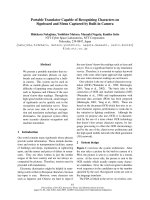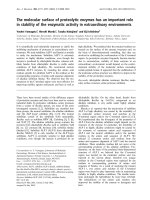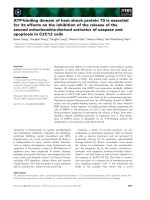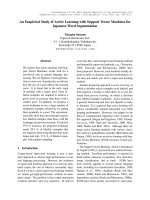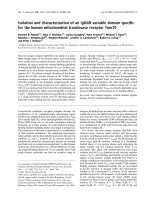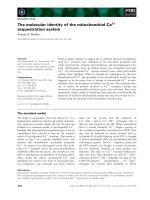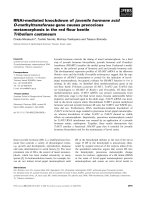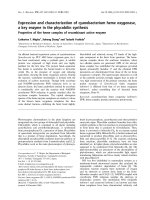Báo cáo khoa học: "Rapid molecular detection of methicillin-resistant Staphylococcus aureus: a cost-effective tool for infection control in critical care" pdf
Bạn đang xem bản rút gọn của tài liệu. Xem và tải ngay bản đầy đủ của tài liệu tại đây (40.75 KB, 3 trang )
Page 1 of 3
(page number not for citation purposes)
ICU = intensive care unit; MRSA = methicillin-resistant Staphylococcus aureus; PCR = polymerase chain reaction.
Available online />Abstract
Control strategies for methicillin-resistant Staphylococcus aureus
(MRSA) in critical care remain debated. Timely detection of MRSA
carriers is crucial to an effective isolation policy. In this issue,
Harbarth and colleagues report rapid MRSA screening among
intensive care unit-admitted patients using a PCR assay. Pre-
emptive isolation for all admissions until screened negative for
MRSA was associated with a reduction of intensive care unit-
acquired MRSA infections in one of two study units. The data
provide preliminary evidence to the effectiveness of a MRSA
control strategy combining rapid screening by a molecular method
and preventive isolation. Further controlled studies are needed to
evaluate the cost-effectiveness of this intervention.
Evaluation of rapid MRSA screening and
preventive isolation
The study reported by Harbarth and colleagues in the previous
issue of Critical Care is the first clinical investigation to evaluate
the impact of a novel molecular assay for rapid screening of
methicillin-resistant Staphylococcus aureus (MRSA) carriage in
the intensive care setting [1]. The authors conducted a
multistep intervention cohort study over a period of 32 months
in two adult intensive care units (ICUs) in a university hospital.
During a baseline phase, screening for MRSA was performed
by culture methods in high-risk patients admitted to these
ICUs. In a first intervention phase, all admissions were
screened for MRSA by PCR. The median time intervals
between ICU admission and notification of screening test
results in the intervention and baseline phases were
compared. In a second intervention phase, all patients were
placed in contact isolation on ICU admission pending rapid
screening results, and the incidence of ICU-acquired MRSA
infection was compared with that of the pre-intervention
period, with adjustment for MRSA colonization pressure.
The implementation of rapid PCR screening reduced the time
to detection of MRSA carriers from 4 days to 1 day. After
implementing extensive on-admission PCR screening and
pre-emptive contact isolation, a substantial decrease of
MRSA infections was observed in the medical ICU but not in
the surgical ICU. Using the PCR method, the number of
unnecessary isolation days was markedly reduced as
compared with the same isolation policy supported by
conventional screening methods.
Rationale for improved MRSA control by
rapid screening
Harbarth and colleagues’ study is important because it
addresses an unmet medical need [2]. MRSA has become
endemic in many hospitals worldwide where it is causing
excess nosocomial infection, particularly in the intensive care
setting. There is mounting public concern about this situation,
as evidence shows that invasive MRSA infection is
associated with a significant increase in mortality and
prolonged hospital care [3,4]. MRSA transmission occurs via
healthcare workers’ hands that become contaminated during
patient care. MRSA colonization places the individual patient
at increased risk of infection and constitutes up to 70% of the
patient reservoir for cross-transmission [1,4]. As confirmed by
Harbarth and colleagues, only a small minority of MRSA
carriers can be detected by culture of clinical samples
whereas performing selective culture of mucocutaneous
colonization sites was 10-fold more sensitive in this endemic
ICU setting [1].
The optimal MRSA control strategy remains debated,
although the ‘search-and-destroy’ approach that combines
active screening, strict isolation and decolonization of carriers
has demonstrated its efficacy in keeping hospitals free of
Commentary
Rapid molecular detection of methicillin-resistant
Staphylococcus aureus
: a cost-effective tool for infection control
in critical care?
Marc J Struelens and Olivier Denis
Department of Microbiology, Université Libre de Bruxelles – Hopital Erasme, Brussels, Belgium
Corresponding author: Marc J Struelens,
Published: 14 March 2006 Critical Care 2006, 10:128 (doi:10.1186/cc4855)
This article is online at />© 2006 BioMed Central Ltd
See related research by Harbarth et al. in issue 10.1 [ />Page 2 of 3
(page number not for citation purposes)
Critical Care Vol 10 No 2 Struelens and Denis
endemic MRSA in The Netherlands and Scandinavia [5,6].
Clinical practice recommendations include MRSA carrier
screening to inform patient isolation and decontamination
procedures, and thereby to more effectively control cross-
infection [4]. Several studies have indeed indicated that this
approach is also cost-effective in endemic ICU settings with
prevalence rates of MRSA carriage on admission ranging
from 4% to 20% [4,7].
Conventional methods are unfortunately too slow for early
identification of MRSA carriers. Culture-based screening
methods usually require 48–96 hours before MRSA
identification. New-generation selective agar media with
chromogenic enzyme substrates perform better but still
require 24–48 hours for presumptive MRSA detection [8].
During this delay of several days between sampling and
reporting of detection results, MRSA carriers may constitute
a source of cross-colonization if no contact isolation
precautions are taken. To address this diagnostic delay, a
cautious alternative is to place ICU-admitted patients in pre-
emptive isolation until proven MRSA-negative.
Technological advances in molecular
detection of MRSA
Molecular assays that detect MRSA in the range of 10
genome copies within 2–6 hours have recently been
developed for screening specimens [8]. The majority of these
multiplex PCR assays simultaneously detect the methicillin
resistance determinant mecA and another gene that is
specific to S. aureus, such as the thermonuclease nuc gene
or the cell wall biosynthesis femA gene.
The IDI-MRSA system (GeneOhm Sciences, San Diego, CA,
USA) targets MRSA-specific DNA elements that bridge the
mobile genetic cassette carrying mecA, called
Staphylococcal Chromosome Cassette mec, and the S.
aureus-specific chromosomal junction (orfX). This design
prevents false-positive signals occurring from mixed flora
specimens containing methicillin-susceptible S. aureus and
methicillin-resistant coagulase-negative staphylococci [9].
Clinical evaluations of this assay have shown that MRSA
could be detected from nasal swabs within 2 hours with high
sensitivity and specificity [9,10].
Real-time multiplex PCR on the LightCycler system (Roche
Applied Sciences, Indianapolis, IN, USA) has also shown
promising performance on testing nasal swabs from neonates
and from adult patients in one study [11].
The assay evaluated in the study by Harbarth and colleagues
used an immunomagnetic separation step for selective
MRSA concentrations from swab specimens prior to DNA
extraction and real-time multiplex PCR. It was initially reported
as very sensitive but not very specific [12], although results
reported here showed lower sensitivity and higher specificity
[1]. Mathematical modeling suggest that using a rapid PCR
assay for MRSA admission screening and patient isolation
should reduce significantly the incidence of hospital-acquired
MRSA infection and should prove cost-saving [13,14].
A technology assessment challenge
Will such prediction prove correct in critical care? The
findings of Harbarth and colleagues [1] provide preliminary
evidence for the medical utility of this new diagnostic
technology. This study provides the first detailed analysis of
diagnostic delays for MRSA screening. It demonstrated that a
screening time of 1 day is feasible using real-time PCR,
thereby enabling a preventive isolation strategy that appeared
to contribute to a reduction of ICU-acquired infections in one
of two units. Why this strategy had no impact in another ICU
remains unclear. As recognized by the authors, their study
had several limitations. Firstly, they used different timings for
implementing the components of their combined intervention
in the two ICUs. Secondly, the impact on MRSA acquisition
and transmission in the ICU could not be assessed because
no screening was performed during the ICU stay and
bacterial isolates were not genotyped. Finally, the model used
for measuring the effect attributable to the intervention did
not adjust for several important confounders. Nevertheless,
the authors should be commended for performing this inter-
vention study that documents the benefit of replacing conven-
tional screening by rapid PCR testing and re-organizing
critical care towards systematic use of barrier precautions.
Commercial PCR tests are becoming available for fast MRSA
detection. As these tests are more expensive and skill-
intensive than conventional tests, controlled trials funded by
independent health technology assessment agencies must
determine the potential medical and economic benefit of
control strategies using this technology in acute care [8].
Study endpoints should include the number of unisolated
MRSA patient-days avoided, the number of unnecessary pre-
emptive isolation days avoided, the increase in the MRSA
decolonization rate, the decrease in the MRSA transmission
and infection rate, the decrease in MRSA-related mortality,
the cost saving due to shorter patient hospital stay and ICU
stay, and the decreased use of glycopeptides. Although such
studies will be costly, the burden of disease caused by
uncontrolled MRSA infection in critically ill patients and the
potential benefits of improved control warrant the effort.
Competing interests
MJS received research grant support from GeneOhm
Sciences and BioMérieux, for clinical evaluation of diagnostic
devices related to the topic of this commentary. MJS has also
received travel grant support from Roche Diagnostics to
attend scientific meetings.
References
1. Harbarth S, Masuet-Aumatell C, Schrenzel J, Francois P, Akakpo
C, Renzi G, Pugin J, Ricou B, Pittet D: Evaluation of rapid
screening and pre-emptive contact isolation for detecting and
controlling methicillin-resistant Staphylococcus aureus in criti-
Page 3 of 3
(page number not for citation purposes)
cal care: an interventional cohort study. Crit Care 2006, 10:
R25.
2. Diekema DJ, Dodgson KJ, Sigurdardottir B, Pfaller MA: Rapid
detection of antimicrobial-resistant organism carriage: an
unmet clinical need. J Clin Microbiol 2004, 42:2879-2883.
3. Cosgrove SE, Qi Y, Kaye KS, Harbarth S, Karchmer AW, Carmeli
Y: The impact of methicillin resistance in Staphylococcus
aureus bacteremia on patient outcomes: mortality, length of
stay, and hospital charges. Infect Control Hosp Epidemiol
2005, 26:166-174.
4. Muto CA, Jernigan JA, Ostrowsky BE, Richet HM, Jarvis WR,
Boyce JM, Faror BM: SHEA guideline for preventing nosoco-
mial transmission of multidrug-resistant strains of Staphylo-
coccus aureus and enterococcus. Infect Control Hosp
Epidemiol 2003, 24:362-386.
5. Nijssen S, Bonten MJ, Weinstein RA: Are active microbiological
surveillance and subsequent isolation needed to prevent the
spread of methicillin-resistant Staphylococcus aureus? Clin
Infect Dis 2005, 40:405-409.
6. Verbrugh HA: Value of screening and isolation for control of
methicillin-resistant Staphylococcus aureus. Clin Infect Dis
2005, 41:268-269.
7. Chaix C, Durand-Zaleski I, Alberti C, Brun-Buisson C: Control of
endemic methicillin-resistant Staphylococcus aureus: a cost–
benefit analysis in an intensive care unit. JAMA 1999, 282:
1745-1751.
8. Brown DF, Edwards DI, Hawkey PM, Morrison D, Ridgway GL,
Towner KJ, Wren MWD: Guidelines for the laboratory diagno-
sis and susceptibility testing of methicillin-resistant Staphylo-
coccus aureus (MRSA). J Antimicrob Chemother 2005,
56:1000-1018.
9. Huletsky A, Lebel P, Picard FJ, Bernier M, Gagnon M, Boucher N,
Bergeron MG: Identification of methicillin-resistant Staphylo-
coccus aureus carriage in less than 1 hour during a hospital
surveillance program. Clin Infect Dis 2005, 40:976-981.
10. Warren DK, Liao RS, Merz LR, Eveland M, Dunne WM, Jr: Detec-
tion of methicillin-resistant Staphylococcus aureus directly
from nasal swab specimens by a real-time PCR assay. J Clin
Microbiol 2004, 42:5578-5581.
11. Paule SM, Pasquariello AC, Hacek DM, Fisher AG, Thomson RB,
Jr, Kaul KL, Peterson LR: Direct detection of Staphylococcus
aureus from adult and neonate nasal swab specimens using
real-time polymerase chain reaction. J Mol Diagn 2004, 6:191-
196.
12. Francois P, Pittet D, Bento M, Pepey B, Vaudaux P, Lew D,
Schrenzel J: Rapid detection of methicillin-resistant Staphylo-
coccus aureus directly from sterile or nonsterile clinical
samples by a new molecular assay. J Clin Microbiol 2003,
41:254-260.
13. Cooper BS, Medley GF, Stone SP, Kibbler CC, Cookson BD,
Roberts JA, Duckworth G, Lei R, Ebrahim S: Methicillin-resistant
Staphylococcus aureus in hospitals and the community:
stealth dynamics and control catastrophes. Proc Natl Acad Sci
USA 2004, 101:10223-10228.
14. Raboud J, Saskin R, Simor A, Loeb M, Green K, Low DE, McGeer
A: Modeling transmission of methicillin-resistant Staphylococ-
cus aureus among patients admitted to a hospital. Infect
Control Hosp Epidemiol 2005, 26:607-615.
Available online />

